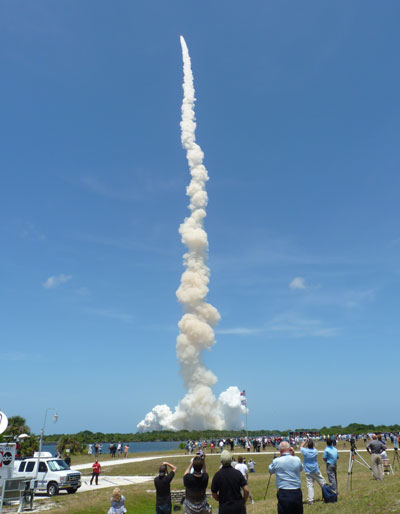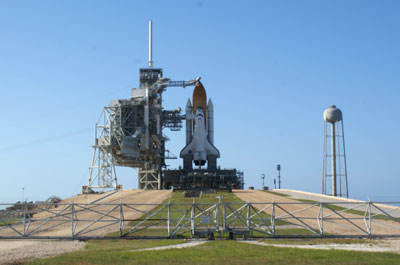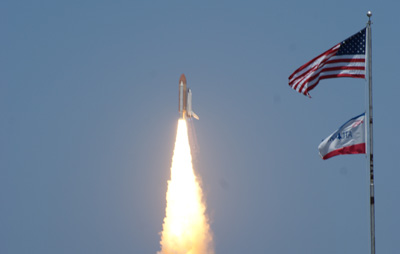The long goodbyeby Jeff Foust
|
| “We’re like a pro athlete performing at the top of their game, and it’s not easy to stay at the top of your game,” said Gerstenmaier of the performance of the shuttle team. |
Within the context of current events, though, it’s a very different story. The shuttle program is winding down, a decision made over six years ago by President George W. Bush and affirmed by Congress, but one that many are starting to become aware of only now, as the final missions approach the pad. It’s of particular interest—and concern—in the “Space Coast” region around KSC, as political leaders and the public alike worry about the economic impact the shuttle program’s end and resulting job losses. That means this shuttle mission wasn’t like any other. In this case, Friday’s launch was the last ever for Atlantis—maybe.
Picture-perfect launch
From a technical standpoint, it was hard to take issue with the countdown and launch. Despite a tight schedule caused by delays last month rolling Atlantis out to pad 39A, launch preparations went smoothly. Shuttle managers said later that the number of IPRs—shuttle-speak for reports filed about potential issues with a shuttle launch—for this mission was likely a record low. Even the fickle Florida weather was cooperating, with partly cloudy skies and modest breezes forecast for launch day.
The only element of drama in the countdown took place relatively late in the process, although it dated back to a problem several days earlier, when crews found a ball bearing in the shuttle’s payload bay. Originally thought to be from ground equipment, engineers later thought it might come from a camera mounted in the payload bay, weakening its support and posing a hazard to on orbit operations.
“The teams did the right thing, they stayed hungry and sharp all week long” trying to track down the source of ball bearing, said mission management team chair Mike Moses after the launch. “We just wanted to be sure this wasn’t a problem.” Moses and others concluded that the chances that the ball bearing came from a camera “were pretty small” and even if it did, the pin holding the camera in place would not come loose. “That was really a non-issue, but we had to talk late about it, which made it seem a little bit more exciting than it probably really was.”
| “Atlantis is telling us, ‘Please use me again,’” said Alexey Krasnov of Roskosmos after the problem-free launch. |
With that problem resolved and weather holding, the shuttle was cleared to fly. And, exactly as planned, Atlantis lifted off just after 2:20 pm EDT Friday. An overall crowd estimated at 40,000 viewed the launch in person, including VIPs such as Secretary of Defense Robert Gates, Russian Deputy Prime Minister Sergei Ivanov, and late night talk show host David Letterman. NASA also invited 150 users of the social network Twitter to view the launch from the press site and “tweet” about the experience. Most, though, gathered along the coastline to witness one of the final shuttle launches.
STS-132 continued a string of several consecutive shuttle missions that launched on or almost on time, with few of the glitches that plagued the shuttle earlier in its history. Some find it ironic that, just as the shuttle program appears to be hitting its stride from an operational standpoint, the program is coming to an end.
Shuttle launch director Mike Leinbach said the smooth flow of recent shuttle missions could be traced to two things: the maturity of the shuttle hardware as well as the experience of teams that operate it. “A mature vehicle and a mature team are going to perform better than a first-time team,” he said. “It’s as simple as that.”
“We’re like a pro athlete performing at the top of their game, and it’s not easy to stay at the top of your game,” added Bill Gerstenmaier, NASA associate administrator for space operations. “I keep challenging the team to keep looking for other ways to not take for granted what’s happening.”
 A crowd at the KSC press site watches the launch of Atlantis on Friday. (credit: J. Foust) |
The case for another mission
Others, though, don’t see the current smooth pace of shuttle operations as ironic. Instead, they argue that this is proof that the shuttle program should not end after the November launch of STS-134, but instead be extended by some degree. Even Alexey Krasnov, head of the Piloted Programs Directorate of the Russian space agency Roskosmos, made a case for extending the shuttle at the post-launch press conference. He noted Ivanov’s visit to KSC had been planned months in advance knowing that it would be “like a miracle it would go exactly this day” yet it did launch as planned. “Atlantis is telling us, ‘Please use me again.’”
Some in Congress have been pressing for a shuttle extension for some time. Bills introduced into the House and Senate earlier this year would require NASA to at least study an extension of the shuttle program. Sen. Kay Bailey Hutchison (R-TX), for example, has argued for stretching out the remaining shuttle missions into next year and even 2012. “That would allow for the analysis and careful planning I believe is needed to minimize the risk to the ISS and bridge part of the gap to new capabilities,” she said at a Senate hearing last week on the future of US human spaceflight. It’s tough to stretch out the shuttle program, though, when there’s only two missions left to go. Or is it three?
Hutchison and others have advocated adding one more mission to the manifest, using the “launch on need” hardware that will be available to fly a rescue mission should there be problems during STS-134 that prevent Endeavour from returning safely. When Atlantis returns from its mission late this month, NASA will begin to prepare it for that rescue mission, but with no plans currently to actually launch it. However, if it does become an actual non-rescue mission, Atlantis would likely be the orbiter to fly it, meaning Friday’s launch isn’t necessarily its last mission.
| “I keep recommending it, and I will keep asking the White House to go ahead and do that,” Sen. Nelson said flying another shuttle mission. |
NASA officials addressed the possibility of flying an additional mission at the post-launch press conference Friday. Gerstenmaier said the best time to fly an additional mission would be in June 2011, so that the additional supplies it would carry would sync up in station operations with upcoming flights of the European ATV and Japanese HTV cargo spacecraft. “Station would be fine without the flight,” he said, “but if want to try and improve it and make things better, and if somebody wants us to go do it, we can go and potentially accommodate them.”
He added that, ideally, a decision on adding that flight needs to come in the near future. “If we were going to make it a real mission, we would probably want to known in June,” he said, “so we could actually start doing the right planning, get things in place, make sure we’ve got the right cargo in place.”
Extending the shuttle program by that additional flight would cost on the order of $100 million a month, Gerstenmaier said. “So it’s probably $600 million to $1 billion to fly it in the June timeframe,” he said. Asked who among the NASA leadership, the White House, and Congress, would make that decision, he replied simply, “Probably all of the above.”
Among those who back the idea of an additional mission is Sen. Bill Nelson (D-FL), who attended Friday’s launch and talked with NASA officials immediately after the press conference. “I keep recommending it, and I will keep asking the White House to go ahead and do that,” he later told reporters. He added that he was skeptical that STS-134 would launch on schedule in late November: he believes that it will slip into early next year, which he argues strengthens the case for an additional mission in mid-2011.
 Atlantis sits on the launch pad the day before the launch of STS-132. Will the orbiter make one more trip to pad 39A? (credit: J. Foust) |
It’s hard to say goodbye
Another advantage of an additional mission is that it would delay, at least for several months, the end of the shuttle program and the layoffs expected to result once the program ends and its sizable workforce is no longer needed. Those job losses, and the resulting economic impact on Space Coast, has become a major concern there as the end of the shuttle program looms especially now as the final flights go off and the future of NASA’s human spaceflight plans is tied up in debates in Washington.
An additional mission, though, would only delay what most recognize as the inevitable: the end of the shuttle program is coming, sooner or later. While many worry about the future, and some protest plans to retire the shuttle, a few are critical that people are only now getting worried—or angry—about the shuttle’s end when those plans were first announced by President George W. Bush when he unveiled the Vision for Space Exploration in January 2004.
“We’ve known about the shuttle program being canceled for six years, and by and large, this community has not reacted to that until this year,” said Jim Banke, a journalist who hosts the “Space Talk” radio show. He spoke at a forum titled “Space, What’s In It for Me?” at Brevard Community College a few hours after the shuttle launch.
The shuttle’s end is an opportunity for the region to diversify its space-related economy so it’s no longer dependent on a single large program like the shuttle. “The future of space in Florida is diversification,” said Frank DiBello, president of Space Florida, at the same forum. “We cannot be dependent on NASA to define our future.” His goal is to triple the size of the state’s space industry over the next ten years by moving beyond NASA and other launch operations into other sectors of the industry, including space-related applications and space tourism.
“Florida will take some hurt to its workforce as we transition, there’s no question about that,” he said. However, “we’re going to emerge stronger, more diversified, and a lot better off.”
| “Personally, it hasn’t hit me yet that it was possibly the last flight” of Atlantis, Moses said. |
A separate challenge, and one less frequently mentioned, is the region’s identity in a post-shuttle era. The shuttle has been flying for nearly three decades, and has become synonymous with spaceflight in the region. Shuttle-related imagery pervades the region, from shuttle-themed playgrounds at fast food restaurants to a shuttle mural on the façade of a souvenir shop hawking 3-for-$10 beach towels. Even Ron Jon Surf Shop, the famous beach store in the heart of Cocoa Beach, has a selection of shuttle toys and souvenirs for sale alongside flip-flops and t-shirts.
That may explain some of the reticence to see the shuttle program end, even if new initiatives can soften the economic blow. The region has invested much of its identity with the shuttle program, seeing it as a symbol of America’s future in space. That future is about to become its past, and who wants to be part of the past?
Those most closely associated with the shuttle program haven’t had much time to reflect on what may well be its final mission. “I’m pretty focused on the orbital activities and the mission ahead of us,” Gerstenmaier said. “I don’t celebrate too much until we get through the mission and have wheel stop, then I can take a break and think about things.”
“Personally, it hasn’t hit me yet that it was possibly the last flight” of Atlantis, Moses said. “It was just another launch, so I’m wrapped up in the focus and attention on that.”
Events may give NASA and the space community a little more time to say goodbye to the shuttle, but that final farewell is coming, sooner more likely than later.
